

I had one major project to complete before completing the scenery base on the lower level, and that was the train order signal in St Charles. I’ve been putting this off for a couple of reasons. First, I’ve never made a full working semaphore before, so I wasn’t sure exactly what I was taking on–the dwarf semaphores I made a while ago gave me a significant head-start, but this was much more complex. Second, I don’t know exactly if the Southern used a semaphore in St Charles – or if they did where it was located – so I was hopeful my procrastination would result some evidence. Alas, I finally just had to bite the bullet and build the thing! Yes, I know there are commercially available semaphore kits, but what would be the fun in that? I’m a glutton for punishment, and I had a bunch of brass stuff laying around, so why not try to scratchbuild one?
I know with 100% certainty that the station in St. Charles had an operator who passed train orders to Southern and L&N crews working the branch. There is both photographic and timetable evidence for this. In the era I model, it was typical for a train order station to have a three-color signal of some sort indicating “red” (stop to sign for orders), “amber” (slow down to pick up orders) or “green” (no orders – proceed), and a three-position semaphore was common. On most stations, the semaphore is built right alongside the station’s office with the control levers inside the station. However, pictures of the St. Charles station clearly do NOT show an adjacent semaphore or any other type of signal. The only thing I can think is that the Baileys Creek Branch to Mayflower cut off the St. Charles main a couple hundred yards geographically south of the station, and train movements on this branch were controlled by the station–perhaps the signal was closer to this junction to allow train crews to see it an heed from both the St. Charles and Baileys Creek Branches. So, that’s what I chose to model!
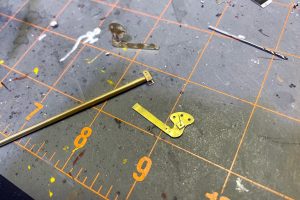
Like my dwarf semaphores controlling access to the coal branches, I wanted the semaphore to be fully operational including lights, blade movement, and fascia-mounted controls. The first job was making some semaphore blades. I did this by making an outline of an upper-quadrant blade in PowerPoint, scaling it to 1:87, and printing it onto a label. After attaching the label to some thin sheet brass, I drilled holes for the lenses, pivot point, and control rod and cut out the blade with scissors, using a file to clean things up. I soldered on the pivot rod, .015″ by bending one end, inserting it through the hole, and soldering it to the blade face. Next I added a small spacer for the blade onto the rod made from a piece of small brass bar bent on itself with a hole drilled through. I painted the blades flat black and insignia red for the blade end. The back of the blade got some silver Sharpie following pictures I’ve seen of other Southern stations. The lenses are just short pieces of fiber optic with one end melted into a round shape using a soldering iron (just hold it near the end of the fiber optic), attached with CA and colored with kids markers.

The mast is a piece of 3/32″ brass tube. I made two mounting plates for the top out of brass bar, filed flat spots onto the tube, and attached them via solder. Next I added some guide loops for the rods that would go from the ground to the blade. I bent something resembling the shape of Saturn out of .015″ brass wire and soldered it tightly around the mast, using a semaphore mast diagram printed to scale as a guide for positioning, three guide loops total. This resulted in two U-shaped loops, one on either side of the mast. I finished the loops by soldering a small piece of wire across each U to make a smaller hole to the outside away from the mast. My soldering skills are not great, so this was a lot of ugly blobs until I took a file and cleaned things up. I added a piece of brass ladder stock by connecting it to the top with solder, bending it, and making U-shaped supports out of .015″ brass wire which I soldered into place in three locations and cleaned up. I painted the mast assembly flat black and then used a combination of silver Sharpie and silver paint to finish it.
Now I was ready to put the blades onto the mast. I fashioned some control rods from .015″ steel music wire, inserted them into the blade holes, and ran them down the guide loops on each side. After inserting the blade pivots into the mounting plate, I bent the brass rod 90 degrees to hold each blade in place while allowing it to pivot freely. I made the base from scraps of plywood (see pictures) and drilled a 3/32″ hole for the mast, two adjacent 1/16″ holes which I lined with 1/16″ brass tubing for the control rods, and a larger hole for the ladder to slide into. I press fit the mast into the holes with the rods going through their brass tubes. Then I ran a piece of fiber optic cable down the tube. I first tried to file one end of the fiber optic at an angle to get it to shine through the blade lenses, but this didn’t work well. I ended up holding the fiber optic over a spare piece of 3/32″ brass tube which I heated with a soldering iron. When the tube got hot, the fiber optic bent itself over the tube in a perfect curve which still conducted light well. A little more heat to make a rounded lens at the end, and I had my “light” for the blades.

I wanted to use .062″ steel music wire (the same stuff I use for manual turnout controls) for the fascia-mounted control rods, so I crafted two triangular levers out of thick styrene hinged at one corner to convert the horizontal control rod movement into vertical movement for the blade control rods. I covered this in some detail with the dwarf semaphores, so I won’t cover it again here. With the mechanism in place, I mounted the base and semaphore assembly in place on the layout. Next, I worked on the control rods made from 36″ pieces of .062″ steel music wire. Where they would cross through benchwork, I drilled 2/32″ holes and lined them with brass tubing. I was able to get a pretty good bend in the control rod without it kinking this way.

The heart of the control rod mechanism is a 3-way slide switch. I bought a handful of these for the dwarf semaphores because of their longer throw, but it turns out they were exactly what I needed to control both the throw and the lights for the full semaphore. I’m using 2-lead, bi-color red/green LEDs for the lights. Controlling the red and green is easy enough with DC and crossing the +/- leads on two of the poles on the switch to get the red and green on the end throws of the switch. For the amber, I wanted to use the AC current from my track power. It took a bit of thinking through the use of the 16 leads (it’s a 4-pole slide) to figure out how to route both AC and DC power to the same LED without ever crossing the streams, but the arrangement seen hand-drawn on my cheat sheet (see gallery below) works well. I secured the rods to the semaphore to the slide switch by bending them 90 degrees and inserting them into a hole drilled through the switch control. A second rod inserted through a second hole in the switch control was run through a piece of 3/32″ brass tubing to the front of the fascia where I capped it off with a wood ball (smaller than the ones I use for switch controls so operators can tell the difference).
The final step was to run LEDs from both switch mechanisms to the fascia where I used stick-on letters and graphic tape to make a little drawing of a semaphore in each direction alongside the track diagram–the operators can look on the fascia to see the color indication if they don’t want to use (or don’t understand) the blade positions on the layout. Finally, I added a second clip to hold orders under the fascia so that the old clip is now “train orders westbound” and the new clip is “train orders eastbound.” So far I’m really happy with how the semaphore looks and now it operates, and it was really fun to build. I know it will add yet another aspect of prototypical operations to the layout as crews now have to read signals to see whether or not they need to pick up orders.
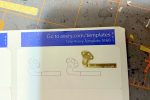
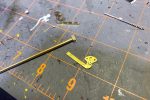
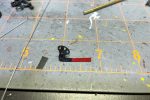
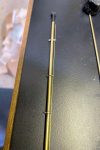
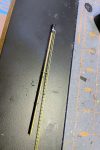


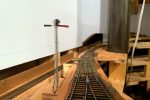




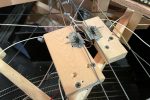


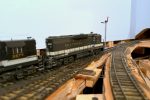
Dan
Nice job on the semiphore.
Bill